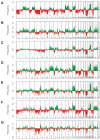DNA copy-number alterations underlie gene expression differences between microsatellite stable and unstable colorectal cancers
- PMID: 19088021
- PMCID: PMC2605660
- DOI: 10.1158/1078-0432.CCR-08-1431
DNA copy-number alterations underlie gene expression differences between microsatellite stable and unstable colorectal cancers
Abstract
Purpose: About 15% of colorectal cancers harbor microsatellite instability (MSI). MSI-associated gene expression changes have been identified in colorectal cancers, but little overlap exists between signatures hindering an assessment of overall consistency. Little is known about the causes and downstream effects of differential gene expression.
Experimental design: DNA microarray data on 89 MSI and 140 microsatellite-stable (MSS) colorectal cancers from this study and 58 MSI and 77 MSS cases from three published reports were randomly divided into test and training sets. MSI-associated gene expression changes were assessed for cross-study consistency using training samples and validated as MSI classifier using test samples. Differences in biological pathways were identified by functional category analysis. Causation of differential gene expression was investigated by comparison to DNA copy-number data.
Results: MSI-associated gene expression changes in colorectal cancers were found to be highly consistent across multiple studies of primary tumors and cancer cell lines from patients of different ethnicities (P < 0.001). Clustering based on consistent changes separated additional test cases by MSI status, and classification of individual samples predicted MSI status with a sensitivity of 96% and specificity of 85%. Genes associated with immune response were up-regulated in MSI cancers, whereas genes associated with cell-cell adhesion, ion binding, and regulation of metabolism were down-regulated. Differential gene expression was shown to reflect systematic differences in DNA copy-number aberrations between MSI and MSS tumors (P < 0.001).
Conclusions: Our results show cross-study consistency of MSI-associated gene expression changes in colorectal cancers. DNA copy-number alterations partly cause the differences in gene expression between MSI and MSS cancers.
Figures


Similar articles
-
Genome-wide differences between microsatellite stable and unstable colorectal tumors.Carcinogenesis. 2006 Mar;27(3):419-28. doi: 10.1093/carcin/bgi244. Epub 2005 Nov 4. Carcinogenesis. 2006. PMID: 16272173
-
Functionally-focused algorithmic analysis of high resolution microarray-CGH genomic landscapes demonstrates comparable genomic copy number aberrations in MSI and MSS sporadic colorectal cancer.PLoS One. 2017 Feb 23;12(2):e0171690. doi: 10.1371/journal.pone.0171690. eCollection 2017. PLoS One. 2017. PMID: 28231327 Free PMC article.
-
Identification of chromosome aberrations in sporadic microsatellite stable and unstable colorectal cancers using array comparative genomic hybridization.Cancer Genet. 2011 Feb;204(2):84-95. doi: 10.1016/j.cancergencyto.2010.08.019. Cancer Genet. 2011. PMID: 21504706
-
Molecular pathological classification of colorectal cancer.Virchows Arch. 2016 Aug;469(2):125-34. doi: 10.1007/s00428-016-1956-3. Epub 2016 Jun 20. Virchows Arch. 2016. PMID: 27325016 Free PMC article. Review.
-
Colorectal carcinogenesis: MSI-H versus MSI-L.Dis Markers. 2004;20(4-5):199-206. doi: 10.1155/2004/368680. Dis Markers. 2004. PMID: 15528785 Free PMC article. Review.
Cited by
-
JAK/Stat5-mediated subtype-specific lymphocyte antigen 6 complex, locus G6D (LY6G6D) expression drives mismatch repair proficient colorectal cancer.J Exp Clin Cancer Res. 2019 Jan 22;38(1):28. doi: 10.1186/s13046-018-1019-5. J Exp Clin Cancer Res. 2019. PMID: 30670049 Free PMC article.
-
Bacterially-Associated Transcriptional Remodelling in a Distinct Genomic Subtype of Colorectal Cancer Provides a Plausible Molecular Basis for Disease Development.PLoS One. 2016 Nov 15;11(11):e0166282. doi: 10.1371/journal.pone.0166282. eCollection 2016. PLoS One. 2016. PMID: 27846243 Free PMC article.
-
Nonsense mediated decay resistant mutations are a source of expressed mutant proteins in colon cancer cell lines with microsatellite instability.PLoS One. 2010 Dec 31;5(12):e16012. doi: 10.1371/journal.pone.0016012. PLoS One. 2010. PMID: 21209843 Free PMC article.
-
Integrative Omics Analysis Reveals Post-Transcriptionally Enhanced Protective Host Response in Colorectal Cancers with Microsatellite Instability.J Proteome Res. 2016 Mar 4;15(3):766-76. doi: 10.1021/acs.jproteome.5b00847. Epub 2015 Dec 29. J Proteome Res. 2016. PMID: 26680540 Free PMC article.
-
Transcriptomic Profiling for the Autophagy Pathway in Colorectal Cancer.Int J Mol Sci. 2020 Sep 26;21(19):7101. doi: 10.3390/ijms21197101. Int J Mol Sci. 2020. PMID: 32993062 Free PMC article.
References
-
- Buyse M, Loi S, van’t Veer L, et al. Validation and clinical utility of a 70-gene prognostic signature for women with node-negative breast cancer. Journal of the National Cancer Institute. 2006;98:1183–92. - PubMed
-
- Shi L, Perkins RG, Fang H, Tong W. Reproducible and reliable microarray results through quality control: good laboratory proficiency and appropriate data analysis practices are essential. Current opinion in biotechnology. 2008;19:10–8. - PubMed
-
- Jemal A, Siegel R, Ward E, Murray T, Xu J, Thun MJ. Cancer statistics, 2007. CA: a cancer journal for clinicians. 2007;57:43–66. - PubMed
-
- Peltomaki P. Role of DNA mismatch repair defects in the pathogenesis of human cancer. J Clin Oncol. 2003;21:1174–9. - PubMed
-
- Lynch HT, Smyrk TC, Watson P, et al. Genetics, natural history, tumor spectrum, and pathology of hereditary nonpolyposis colorectal cancer: an updated review. Gastroenterology. 1993;104:1535–49. - PubMed
Publication types
MeSH terms
Grants and funding
LinkOut - more resources
Full Text Sources
Other Literature Sources
Medical
Molecular Biology Databases

